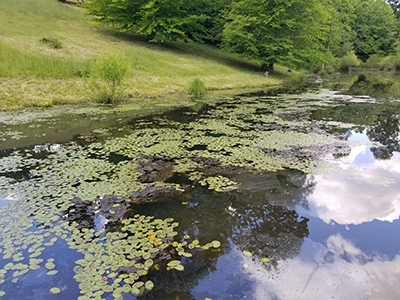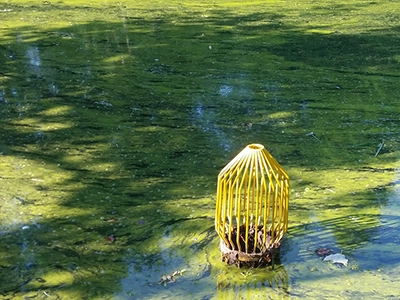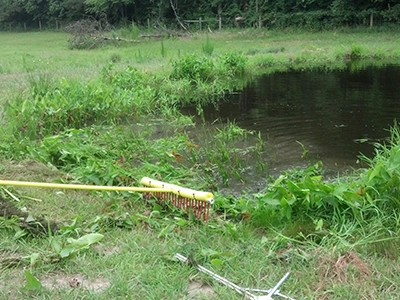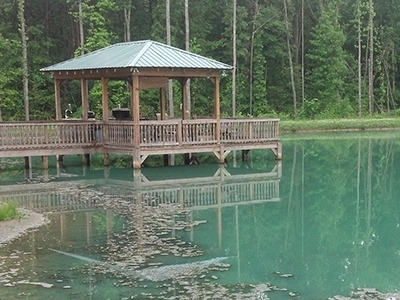When to Treat Weed & Algae Growth: Your Complete Timing Guide

WHAT’S IN THIS BLOG?
o When should you apply Pond Treatments?
ο Understanding Seasonal Treatment Windows
ο Water Temperature Guidelines for Treatment Success
ο Recognize Early Warning Signs
ο Treatment Frequency and Maintenance Schedules
ο Regulatory Compliance and Timing Considerations
ο Maximizing Treatment Investment Through Strategic Timing
ο Your Next Steps for Effective Pond Management
Timing is everything for managing weeds and algae in in your pond. If you treat Weed & Algae growth too early, and you might waste money and time. Wait too long, and you could face costly fish kills and out of control algae blooms or weed growth. Understanding the optimal timing for different pond treatments ensures your pond is the perfect aquatic environment for fish and other wildlife.
Your pond management expert will look at seasonal patterns, water temperature changes, and early warning signs that indicate when to apply a pond treatment. Whether you’re managing a residential pond, overseeing stormwater retention ponds, or maintaining agricultural ponds, proper planning, and strategic timing can mean the difference between minor pond maintenance and expensive ongoing treatments of Weed & Algae growth projects.
Understanding how different aeration systems function will help you choose the right solution for your specific pond conditions and maintenance goals.
Spring: The Prevention Season
Spring marks the most critical time for pond management. As water temperatures rise above 50°F, dormant algae spores begin activating, and aquatic weeds start growing. This spring window—typically March through May, depending on your location—offers the best opportunity to apply pond treatments to keep algae and weeds in check.
Early spring algaecide applications prove most effective because they target algae before growth begins. During this period, lower water temperatures allow your to apply pond treatments to work more gradually, reducing stress on fish and harming beneficial bacteria. Additionally, spring nutrients from runoff and decomposing organic matter create perfect conditions for out of control algae growth if left untreated.
Aquatic herbicide applications to treat pond weeds also yield better results during early spring. Emerging pond weeds are most successfully treated in this time period, making this the optimal time for systemic herbicides that target pond weed root systems.
Summer: Managing Active Algae and Weed Growth
Summer brings peak growing conditions for both desirable and problematic aquatic vegetation. Water temperatures above 70°F accelerate biological processes, making this season the most challenging, as well as the most important for pond management.
During hot summer months, algae blooms can develop rapidly—sometimes within 24-48 hours under ideal conditions. The best solutions to treat weed & algae growth in summer are quick-acting contact algaecides can control algae, but timing the algaecide applications for early morning or late evening prevents shock to fish and maximizes treatment effectiveness.
In the summer, avoid applying pond treatments during extreme heat waves when dissolved oxygen levels drop. The combination of high temperatures, treatment stress, and reduced oxygen can trigger fish kills.
Fall: Preparing for Dormancy
In the fall a pond owner, should focus on reducing organic matter that will decompose over winter, creating increased nutrient levels for next year’s algae growth. September through November represents the best time for pond clean outs, adding beneficial bacteria, and vegetation management.
Late-season herbicide treatments target perennial weeds before they store energy in root systems for winter survival. This timing prevents robust spring growth while avoiding the peak growing season when treatments might stress the entire aquatic ecosystem.
Winter: Strategic Planning Phase
Winter provides a natural treatment break in most climates, but this dormant period can be a crucial planning time. Use winter months to evaluate the previous year’s treatment, research new products, and prepare to apply pond treatments.
Ice cover creates unique conditions that can concentrate nutrients and organic matter. Winter aeration can help ensure you’re ready when spring arrives.
Temperature plays a decisive role in treatment effectiveness. Most algaecides work optimally between 60-80°F, while many herbicides require sustained temperatures above 65°F for effective absorption.
Cold water treatments (below 50°F) generally work slower and may require longer contact times the plant. However, this extended treatment period can benefit treatments that need time to move throughout the entire plant. Conversely, treating weeds & algae growth with chemicals applied in water above 85°F may work too quickly, potentially causing oxygen depletion with rapid plant decomposition.
Monitor water temperature consistently using reliable thermometers, and be sure to check the temperature at multiple depth levels. pond water surface temperatures can fluctuate dramatically throughout the day, while deeper waters maintain more stable water temperatures.
Successful pond management requires recognizing problems before they become emergencies. Early pond maintenance to determine what type of pond treatments are needed will save money, protect aquatic life, and keep your pond clean and healthy.
Water clarity issues can signal pond issues weeks before visible algae blooms appear. Slight green tints, reduced visibility depth, or unusual odors indicate rising nutrient levels and potential problems. Addressing these early warning signs will prevent major bloom events.
Excessive aquatic vegetation growth follows predictable patterns. Small patches of invasive weeds can quadruple in size within weeks under favorable conditions. Early treatment of isolated weed patches proves far more cost-effective than managing widespread infestations later.
Fish behavior changes also indicate developing water quality issues. Fish gasping at the surface, unusual feeding patterns, or congregating in specific areas often precede major algae blooms or oxygen depletion events.
Preventive Treatment Schedules
Proactive pond management follows predictable seasonal schedules that prevent major issues before they develop. Most successful pond owners implement three primary treatment periods annually: early spring prevention, mid-summer maintenance, and fall preparation.
Spring prevention typically involves a single broad algaecide application combined with beneficial bacteria introduction. This foundation treatment sets the stage for season-long water quality management.
Summer maintenance usually requires monthly monitoring with targeted treatments as needed. Rather than calendar-based applications, water testing, temperature monitoring, and visual assessments can provide better results.
Fall preparation focuses on nutrient management and cleaning dead trees, brush and other decaying organic matter out of your pond. Single applications of pond dyes, beneficial bacteria, can help prepare ponds for winter dormancy.
Responsive Treatment Timing
Despite preventive efforts, responsive treatments sometimes become necessary. Rapid response proves crucial when dealing with fish kills, regulatory violations, or customer complaints.
Algae bloom responses require immediate action, typically within 24-48 hours of detection. Quick-acting contact algaecides provide fast results, but follow-up treatments may be necessary to prevent reoccurrence.
Regulatory Compliance in North Carolina and Timing Considerations
State and local regulations often dictate specific timing requirements for aquatic treatments. Many jurisdictions restrict herbicide applications during fish spawning seasons, typically April through June, while others prohibit treatments near drinking water intakes during peak demand periods.
Permit requirements frequently specify application windows, mandatory waiting periods, and seasonal restrictions. Understanding these regulatory timing requirements prevents violations that can result in significant fines and legal complications.






